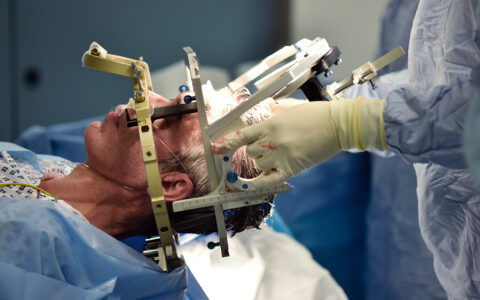The pandemic shutdown moved most Americans onto web-based platforms such as texting or Zoom, a trend that has penetrated educational, business and healthcare systems in enduring ways.
James S. Powers, M.D., a professor of geriatrics at Vanderbilt University Medical Center and director of clinical innovation for the Veterans Administration’s Tennessee Valley Healthcare System, has a long nurtured a vision for dementia patients to improve their lives through telehealth interactions.
“In an environment where geriatricians and other specialists are at a premium, primary care, supported by geriatrician consults appears to be a best way of delivering the kind of support and care needed by people living with dementia,” Powers said.
This vision led Powers to develop a model of dementia care that relies on virtual office visits, e-consults, and virtual group caregiver support. He created the model after reviewing surveys of patient and caregiver preferences and on his experience leading the Geriatric Patient Aligned Care Team — a patient-centered medical home. A study based on his work with this model was published in BMC Geriatrics in May 2025.
Recently, Powers put the model to the test within the VA Tennessee Valley Healthcare System, where small-scale applications with demonstrated success may lead to broader adoption, ideally with support from the Centers for Medicare & Medicaid Services, he said.
Revolving Door for Patients
The number of people over 65 and living with dementia is estimated at 6.2 million, but is expected to double, reaching 13.8 million by 2060. Powers said the 50 million or so volunteer family caregivers existing today face urgent support needs.
Under current practices, individuals with symptoms of dementia are typically referred to a specialist.
“That works with cancer care and with cardiology, because we have a lot of those specialist networks. It doesn’t work for dementia,” Powers said. “This problem is so big, and there aren’t enough neurologists, psychiatrists or geriatricians to take care of these folks.”
“It’s talking with families and caregivers…Who better to deal with that than the primary care doctor who knows the family, and knows the service area and what might be offered locally?”
Referral after referral can lead patients to a point where they drop off the radar altogether.
“Families become frustrated with long waits, limited treatment options, and lack of information about support services,” he said.
Neurologists often see patients where the diagnosis of dementia is not clear. Others, with early signs of dementia, may be candidates to enter a clinical trial for new intravenous anti-amyloid drugs.
“Care for most dementia patients, however, is really about supportive care,” Powers said. “It’s talking with families and caregivers about living arrangements and support systems. Who better to deal with that than the primary care doctor who knows the family and knows the service area and what might be offered locally?”
Scalable Model
Starting in 2018, Powers dementia care model combining primary care and geriatric consults was used to assist caregivers of people with dementia. All were part of the VA hospital system, including members of a centrally-located support group offering a four-week virtual curriculum to caregivers with social-worker support provided throughout.
The primary care providers – including physicians, physician assistants and nurse practitioners — were given education about dementia diagnosis and management in the primary-care setting. They were also assigned a geriatrician for consults.
Through 2024, geriatric consults averaged 14 per month, for a total of 1,176. During these consults, geriatricians recommended diagnostic testing, new medications and elimination of other prescription medications. They gave occasional referrals for formal neuropsychological testing or psychiatric services, pursued goals-of-care discussions, and advised on patient safety, home and community-based services, and caregiver support.
Other suggestions included blood panels for B12, thyroid deficiencies and metabolic abnormalities. Recommended mental status exams were carried out, often by a clinic nurse or social worker in a 5- or 10-minute screening process.
Cost Savings, Satisfaction
Once the habits of referral and transfer of care are broken, primary care physicians widely report satisfaction with the model, Powers said. Physicians often express appreciation for the help and of feeling more empowered and educated about this complicated disease.
“Patient and caregiver feedback indicates they like seeing their primary care person because they know them,” Powers said. “This is a chronic illness, so they will need ongoing support; they are glad to avoid traveling a distance to see a consultant they don’t know.”
Efficiency and Results
The Veterans Administration hospital operates as a value-based purchasing system with an emphasis on cost-avoidance, which this model of care clearly supports.
“This model saves on visits to homes and and group telehealth caregiver support raises social workers’ productivity by a factor of four,” Powers said. “Broadly, the research shows that telehealth consultation improves access, eliminates no-show rates, serves to educate and support primary care physicians, and can combine to enhance the caregiver’s experience of care.”




